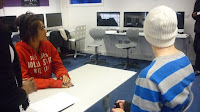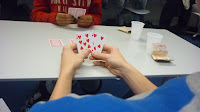For our thriller, we came up with several ideas then cut them down to our four best ideas. We then decided that the ideas were not that great, so we decided to combine some ideas and came up with a final idea. Most of the ideas we came up with had some sort of problems, from location to filming.
The presentation below shows the finalised ideas we came up with.
Thursday, 31 January 2013
Tuesday, 29 January 2013
Prelim: Evaluation
The prelim which we created wasn't as great as we expected it to be for several reasons, although we did manage to post it to the blog on time.
The first problem that we ocame across was that one of our group members was away; therefore the planned plot for the prelim had to be altered - we could not follow the original storyboard we created. On the day, we had to improvise whilst stickin to the similar storyline. Doing this did consume a lot of the filming time we had. However, this can be seen as beneficial because when filming for the thriller we may come across a similar problem; as a result, we would know how to tacklt this type of dilemma if we are faced with it.
As a lot of time had been spent on altering our storyline and filming the scenes, we cut into the time we had for editing our prelim. This was a huge set back for us as we did not get to use much effects as we had hoped to use. But, we managed to cut clips and put the clips in the right order. This also meant that we did not have much time to add sounds to the clip, despite doing research and selecting the sounds we intended on using. From this, we learnt that we could've started on creating sounds to add to the clip on Soundtrack Pro whilst the film was being edited.
A good thing that came out of this was that we learnt to use the 180° rule effectively. We also used a variety of camera shots, such as close up and panning. There was one point where the clip was too long and seemed a bit boring, but we could not cut this as we did not have other clips which would be suitable to use. As a result of this problem, we have gained the knowledge to not have long lengths of clips without cuts when creating the thriller.
This prelim activity was very helpful for us in understanding the 180° rule, as well as showing us how difficult it is to edit in a short amount of time and the use of different camera shots & angles. For the thriller we hope to not repeat the same mistakes.
Monday, 28 January 2013
Prelim: Bloopers
BLOOPERS
A collaboration of all the mistakes and jokes we had during the filming of the Prelim.
Prelim: Final
This is the final version of our
Prelim. The film didn't follow the storyboard completely as one of our team members was ill, therefor we had to improvise. We didn't have enough time to add transitions and a title sequence however we managed to add some non diagetic sound.
Friday, 25 January 2013
Prelim: Editing
This is the process of editing the storyboard of the Prelim. We were putting it into the correct order and adding annotation to each screen shot to describe the camera angle and what is going on in the shot.
Here is the process of editing the Prelim using Final Cut Pro.
Adding non-diagetic sound using Sound Track Pro.
Thursday, 24 January 2013
Prelim: Filming Photos
Monday, 21 January 2013
Prelim: Planning
This lesson we were working on camera angles and learnt about the 180° rule. The video below explains what the 180° rule in media/film is.
Our brief was to film a person walking into a room and taking part in an activity which consisted of an interaction with someone. We had to ensure that at least one match-cut, shot-reverse-shot were used; as well as showing our understanding of the 180° rule by not breaking it.
Our group decided to set and film a poker game because it would help to demonstrate a good use and understanding of the 180° rule. We would also be able to put into practice our understanding of other shot types such as over-the-shoulder shots and close ups.
For this activity we needed some props:
sunglasses - used to hide identity of character to add mystery
drink & cups - create an atmosphere that they are in a casino
money - for the poker game
cards - for the poker game
hat
Our brief was to film a person walking into a room and taking part in an activity which consisted of an interaction with someone. We had to ensure that at least one match-cut, shot-reverse-shot were used; as well as showing our understanding of the 180° rule by not breaking it.
Our group decided to set and film a poker game because it would help to demonstrate a good use and understanding of the 180° rule. We would also be able to put into practice our understanding of other shot types such as over-the-shoulder shots and close ups.
For this activity we needed some props:
sunglasses - used to hide identity of character to add mystery
drink & cups - create an atmosphere that they are in a casino
money - for the poker game
cards - for the poker game
hat
Thursday, 17 January 2013
Genre & Sub-genre
Genre , Sub genre & Audience.
Genre is the theme of a film In film theory it refers to the method based on similarities in the narrative element from which films are constructed. Most theories of film genre are borrowed from literary genre criticism. Sub genres are identifiable sub-classes of the larger category of main film genres, with their own distinctive subject matter, style, formulas, and iconography. Some are them are prominent sub-genres, such as: 'chick' flicks, detective/mystery films, disaster films, fantasy films, romances, sports films, supernatural films, and thriller/suspense films and so forth. There are also minor film sub-genres. Target audience is the group of categorised people you target to watch the film. For example teenagers, males or females, old people. It is who you make the film for really.
 |
| The Others |
Examples from a film that demonstrates the genre through key signifiers from the films front cover or poster, is the 'The Others'. The genre & sub-genre is a psychological horror - thriller. Target audience would be teens/adults, because of the type of film it is, it wouldnt be directed at children. The key signifiers consists of the dark ere colours, blurred font and the character - Nicole Kidman's facial expression.
 |
| In Time |
'In Time'
Genre & Sub-genre: Action thriller, futuristic.
Target audience:
Males and teenagers
Key Signifiers:
Gun, actors and colours.
 |
| Dream House |
'Dream House'
Genre & Sub-genre:
Horror Thriller
Target Audience:
Key Signifiers:
Rusty font, dark colours, girls face.
Genre & Sub-gnere:
Fantasy Thriller
Target Audience:
Children, teens, people into fantasy movies and Harry Potter novels.
Key Signifiers:
Young characters, font, setting
Fantasy Thriller
Target Audience:
Children, teens, people into fantasy movies and Harry Potter novels.
Key Signifiers:
Young characters, font, setting
Arlington Road - What we had to do when editing
Below are Screen grabs to show what we came across when editing the opening of Arlington road and adding conventions to the opening on Final Cut Pro:
This is a screen grab of when we had to decide the opening order, which scene goes where and how to add it to final cut pro.
This is another example of a screen grab of when we had to decide the opening order, which scene goes where and how to add it to the final cut pro.
This is a screen grab of when we added conventions and how we were in the process of creating the text and where to put the text in the order of conventions.
This is a screen grab of the title convention but with the green box outside it which enabled us to position it and move the title wherever we wanted to on the scene.
This is a screen grab of how we edited are texts such as the colour, the size, the style of font and the angle.
This is a screen grab of how the edited text came out we changed the colour and also moved it to the left, it also shows where the text is going to appear in the opening by that purple box on the timeline.
This is a screen grab of when we had to decide the opening order, which scene goes where and how to add it to final cut pro.
This is another example of a screen grab of when we had to decide the opening order, which scene goes where and how to add it to the final cut pro.
This is a screen grab of when we added conventions and how we were in the process of creating the text and where to put the text in the order of conventions.
This is a screen grab of the title convention but with the green box outside it which enabled us to position it and move the title wherever we wanted to on the scene.
This is a screen grab of how we edited are texts such as the colour, the size, the style of font and the angle.
This is a screen grab of how the edited text came out we changed the colour and also moved it to the left, it also shows where the text is going to appear in the opening by that purple box on the timeline.
Subscribe to:
Posts (Atom)
















































